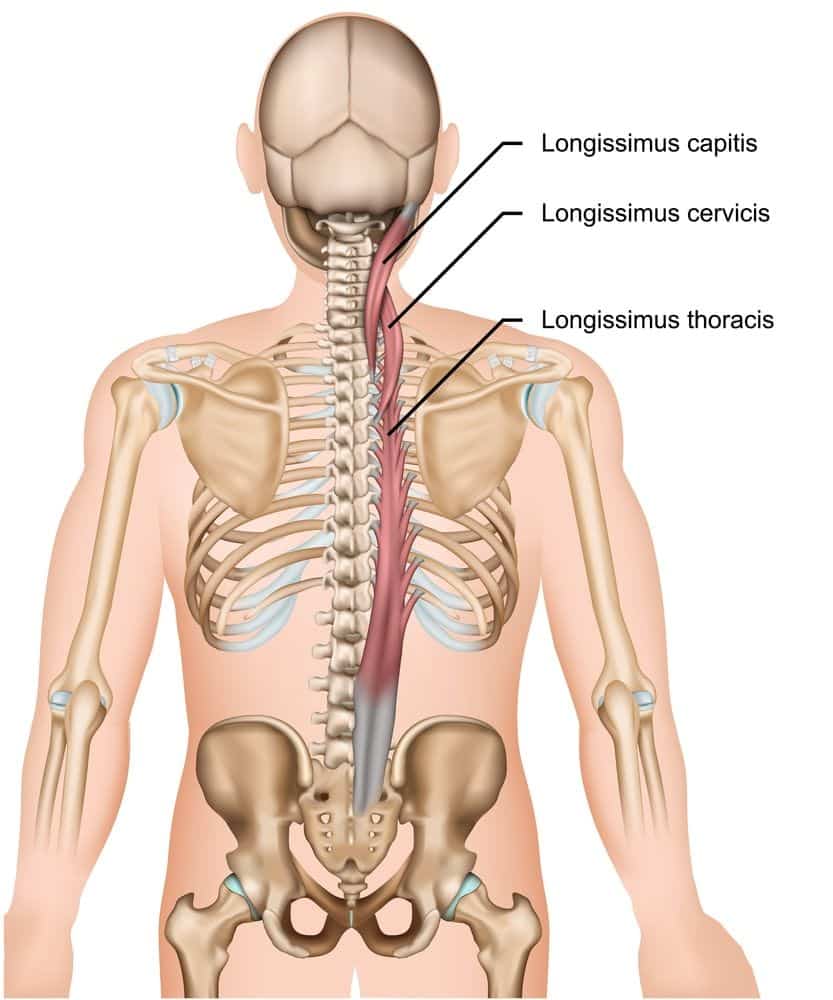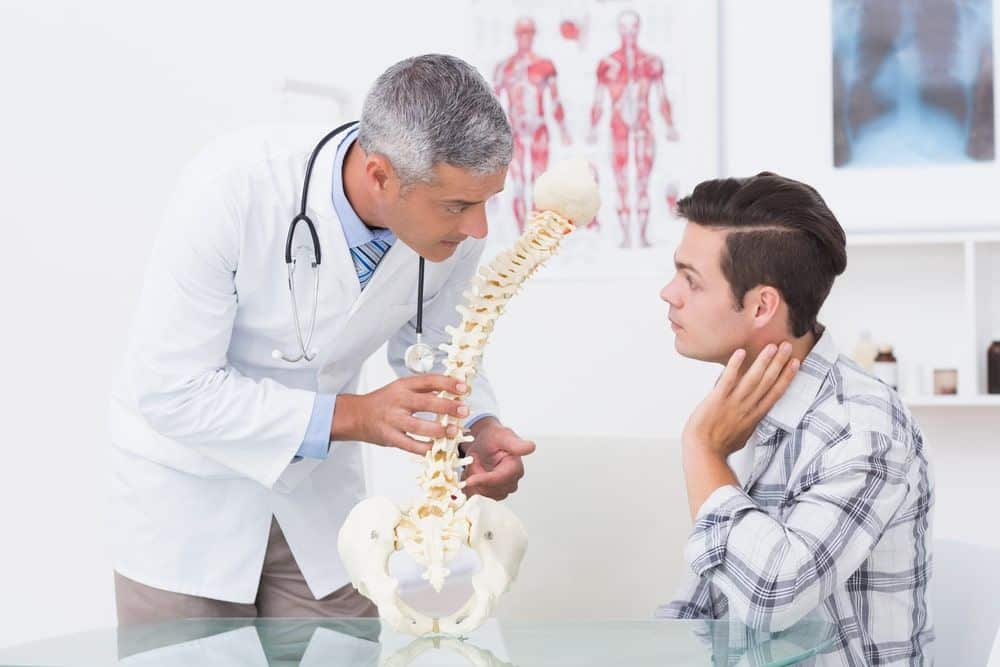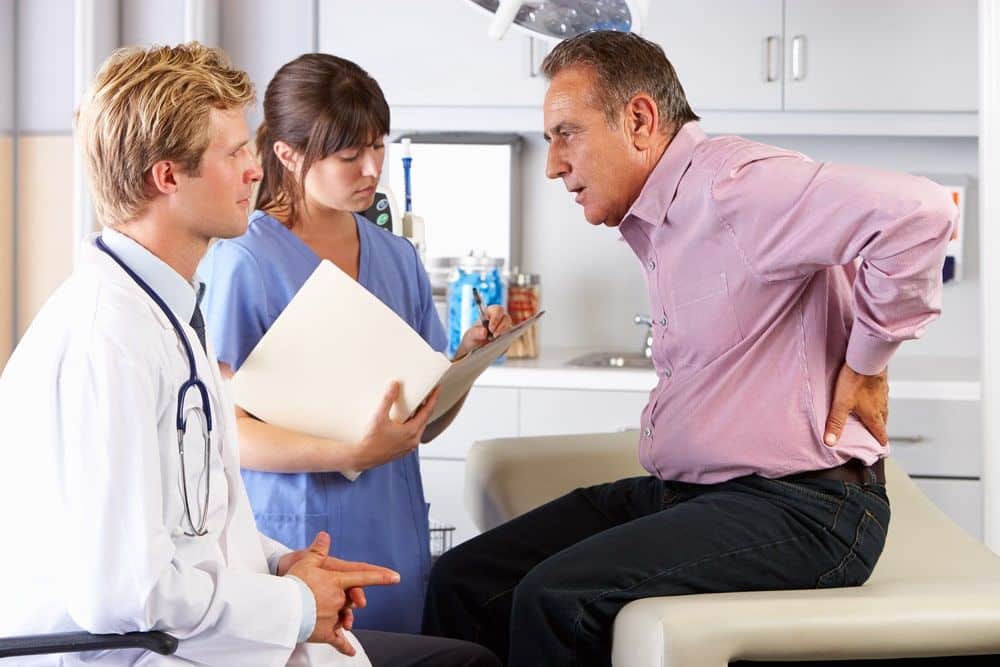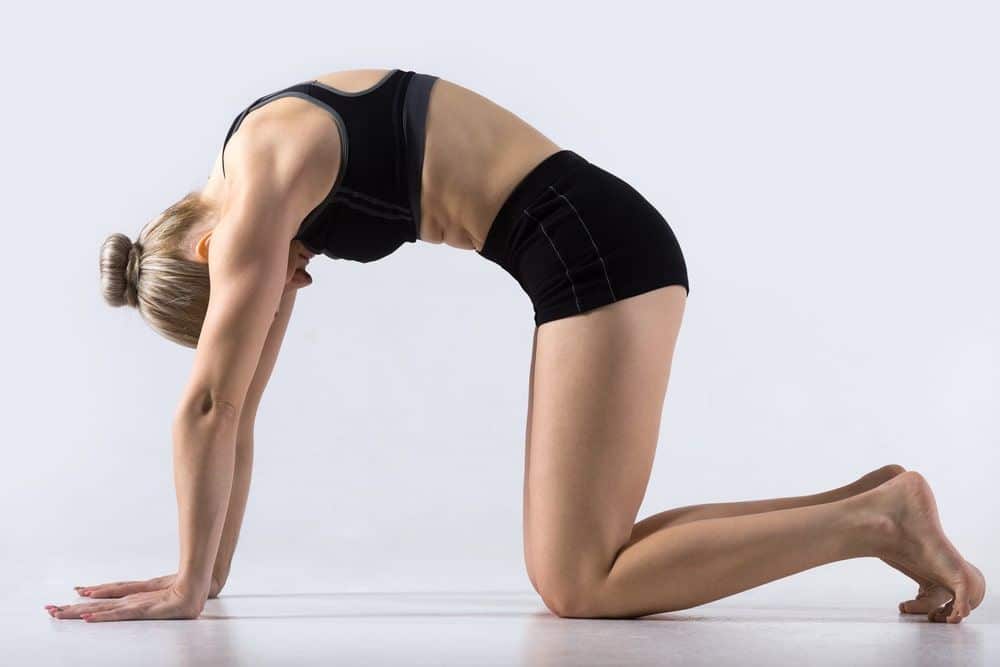If you suffer from back pain, you may know all the reasons “why” – maybe you’re recovering from an injury, or maybe you sit for long hours every day, or maybe your exercise routine doesn’t include back-isolating movements.
Whatever the reason, strengthening your erector spinae muscles is a near-sure bet to relieve back pain and your ongoing aches and pains and eliminating back spasms or tightness in your hips.
What Is the Function of the Erector Spinae?
The erector spine muscles — also referred to as the lumbar erectors, or sacrospinalis muscles — are the largest stabilizing muscles of your back. Stretching from your neck to your pelvis, the erector spinae muscles are in the intermediate layer of your deep intrinsic back muscles.
They attach along your spinal column, allowing you to extend, twist, and bend your body. The function of these important core muscles is not only to help you stand upright, but to help you move in pretty much every direction as well.
Erector Muscles Help You Stand
The spinal erector muscle group is sophisticated and complex. Each muscle group has its own subgroups with unique functions. As their name suggests, the erector spinae muscles help hold us upright and erect. We need strong back erectors to move through our daily life.
Erector Muscles Help You Move
The spinal cord serves as an essential link between the brain and body, and spinal stability is crucial. The erector spinae play a fundamental role in stabilizing the spine.
What’s Causing Your Back Pain
Most American adults sit for an average of 10 hours per day. Not only do many people sit for so long, but it’s common for people to slouch when they’re sitting, especially when on a couch or in a comfortable chair, or when working on a computer or looking at a phone.

When you slouch, your back rounds forward between the shoulders, your chest droops, and your neck and head are pulled forward and down.
Over time, your back muscles become weakened, and if you sit in such poor posture for many hours per day, you may not notice when you slip into an inactive, sedentary lifestyle.
Poor posture results in the muscles of your head and neck being pulled forward and out of alignment. which leads to lengthening the erectors.
Weakening of the erector spinae muscles contributes to lower back pain and tightness. That is why you may feel the need to “stretch” your back. However, improper stretches only worsen the problem.
Anatomy of the Back & Erector Spinae Muscles
The erector spinae muscle group is significantly responsible for your strength and core stability.
They attach along your spine from neck to pelvis, and because of their position in the deep layers of back muscle, erectors help you navigate through life comfortably.
They work together to extend, flex, and rotate the spine and move your entire torso.

The erector spinae is the middle layer of deep back muscle tissues, sandwiched between the superficial Intrinsic layer (spinotransversales) and the deep intrinsic (transversospinalis) layer.
- Superficial Intrinsic Muscles: the top layer of the deep intrinsic back muscles that rotate and extend the spine.
- Intermediate Intrinsic Muscles: including the erector spinae muscles
- Deep Intrinsic Muscles: the innermost muscle layer of the back that mainly controls segmented spine motions.
The erector spinae group has three subgroups:
- Spinalis muscles
- Longissimus muscles
- Iliocostalis muscles
Spinalis Muscles
The spinalis muscles run alongside and lie closest to the spine, linking neighboring vertebrae to each other. They are the innermost erector muscles and assist with turning your head.
Longissimus Muscles
The longissimus muscles are the central back erectors and are the longest and thickest layer. The longissimus stabilize the central spine, stretch the lower back, and rotate the head and neck.
Iliocostalis Muscles
The iliocostalis muscles attach to the ribs and help the torso move comfortably. They are the farthest from the spine and assist with breathing, bending, and stretching the torso.
Common Back Pain Associated with Erectors Muscles

More than 31 million people experience back pain. It’s common to feel pain in the lower back (lumbar), middle back, upper back and shoulders, or all the areas at different times, depending on the muscle exertion you experience.
Because of the size and placement of the erectors muscles, (they are integral to so many day-to-day activities!) most back pain might be associated with weak or overtight spinae erector muscles.
The good news is that strengthening the erectors will ease pretty much any type or level of chronic back pain.
The most common back pain symptoms include:
- Aching and throbbing
- Tight muscles
- Straining with movement
- Sharp or sudden pain
- Muscle spasm
- Sudden weakness
Symptoms of weak back erectors include:
- Muscle pain or spasm on one side of the lower back.
- Pain after twisting or bending.
- Discomfort rotating your head and neck.
- Low back pain that radiates to the buttocks or hips.
The most common causes for these symptoms are inflammation, muscle strain, and muscle tear.
Additionally, these muscles become tight if you live a sedentary lifestyle and your spinae erector muscles do the work to make up for weak abs, lats, and glutes.
When your exercise routines are not well balanced, or if you don’t make a regular point to engage the largest muscles in your core and legs, your back can end up taking on extra work, which pulls major joints in your hips and chest out of alignment, causing you pain.
These conditions contribute to a weak core, which leads to additional muscle imbalances.
Getting Help for Your Back Pain
An experienced musculoskeletal professional, such as a chiropractor, will help you identify the root cause of your back pain.
If it is your erectors muscle, there are a number of routine, simple, effective at-home stretches and exercises to help you experience immediate relief from back pain caused by problems with your spinae erectors.

Don’t simply start stretching without proper guidance. We give some guidelines, but it’s best for you to speak with your chiropractor to create a personalized strength and resistance wellness program to strengthen your erectors and stabilize your spine.
Chiropractic Care for Your Erector Spinae Muscles
Chiropractic care is one of the most popular and effective ways to relieve back pain. Chiropractic treatment specializes in the care of your body’s joints, muscles, nerves, and skeletal alignment.
Over time, as your muscles remain tight and locked into cramped or unnatural positions due to your injuries or lifestyle, the bones and joints get pulled out of position.
An experienced chiropractor provides an examination and diagnosis of the sources of your pain, based on your body’s alignments.
If your muscles are tight and your joints are out of their proper placement, your chiropractor can provide relief by physically manipulating your joints back into place, which helps alleviate any muscle strain.
In the case of your erector spinae, a chiropractor can diagnose exactly which muscles are pulling your spine out of alignment, and whether the problem extends to your shoulders, hips, legs, and beyond.
They’ll discover what might be straining the muscles and analyze the points of highest and lowest pressure.
Then, in addition to discovering the sources of your problems, an experienced and knowledgeable chiropractor creates a customized treatment plan and enacts solutions, providing relief to your ailments.
Stabilize Your Spine While Stretching & Exercising
If you’re recovering from weakened erector spinae muscles, you’ll want to begin a stretching and exercise routine to strengthen your back muscles, realign your posture, and increase your mobility.

However, you must be cautious and only proceed into a new exercise routine with care.
Proceeding under the supervision of a licensed or experienced chiropractor, physical trainer, or other rehabilitation exercise medical professional is always the advisable and best-case scenario.
When it comes to your spine, “stability” and “strength” don’t necessarily have the same meaning: Stability controls force. Strength produces force.
When you think about it like that, it’s easy to remember that some exercises will ask you to use your spine to stabilize your movements, and other exercises will ask you to use your spine to produce movements.
Stabilizing your spine helps you avoid hurting yourself during new, unfamiliar, or strenuous activities. When the muscles of your spine are strong, they keep your body in safe positions without straining, so you don’t harm yourself.
When you suffer from back or neck pain – whether chronic or acute – stabilizing your spine with your errector spinae is essential.
When you have proper spinal mechanics and stabilization, the spine will always be protected and regular movements like sitting, standing, carrying, and lifting are performed efficiently – without you even thinking about it.
Unfortunately, many people aren’t aware of proper exercise form and the mechanics of good spinal stability, which could lead to someone damaging their important spinal structures.
Stretch & Strengthen Your Erector Back Muscles
Stretching the muscles elongates them, which increases blood flow and adjusts their position and movements in your body. Stretch your back erector muscles once or twice per day, to experience relief from tight muscles and back pain.
It’s important to also rest after working out. Resting stimulates growth and allows muscle recuperation. The body uses rest time to repair micro-tears and supply nutrients that build the muscle fibers.
Common stretches for activating and engaging he erector spinae are:

- The double-knee to chest stretch
- the forward-fold stretch
- the cat yoga pose
The goal when you’re stretching your erector spinae muscles is to curve your back forward. Tucking your chin into your chest can help you achieve the proper form.
Exercises for Your Erector Muscle
Before you start any exercise or workout program, consult your doctor or chiropractor first. This helps guarantee that there are no underlying issues that could impact your health.
Taking part in an exercise program that is more strenuous and demanding than your body can manage can lead to injuries or more severe medical problems.
Common exercise workouts for strengthening the erector spinae muscles include:
- the cat-cow yoga pose
- double-leg kick exercise
- back extension exercises on a ball
As is crucial with any exercise program, make sure to start off slow and with a manageable intensity level, then slowly increase the challenge and intensity over time.
Your Posture Affects Your Erector Muscles
Often when you are tired or have to sit for extended periods of time, you slouch.
When done frequently, the body and brain make slouching your “default” posture. You may think that slouching is easier on the back muscles than an erect posture, but that is a common misconception.
Slouching causes the erectors to work harder, leading to tightness, which gradually leads to pain in the abdomen, hips, ribs, shoulders, neck, and head.
Improving your posture helps strengthen your erector spinae muscles in a natural, casual way, but it can take a lot of dedication and energy as you go about your day-to-day activities.
Remember to sit tall and not slouch, keeping your spine aligned and your shoulders squared above your hips. Breathe deeply into the bottom of your ribcage, and squeeze your shoulder blades together if you find yourself beginning to lean forward.
Check your posture throughout the day. Maintaining correct posture may be difficult at first, but as you do it more often, you’ll find you experience less back pain in your day.
Final Word on Erector Spinae Muscles & Back Pain

Back pain affects millions of people, and if you’re one of them, chances are that you’re seeking relief. Whether it’s upper, lower, or middle back pain, it’s very possible that your erector spinae muscles contribute to your discomfort.
Caring properly for your back erector muscles will help alleviate not only your back pain but can lessen pain in your chest, neck, hips, and legs as well.
While many people find relief from over the counter medications, the best long-term solutions are stretching, exercise, and physical treatments such as physical therapy or chiropractic care.
An experienced and knowledgeable chiropractor will apply proper manual release techniques to restore your posture, align your out-of-place joints, and relieve your ongoing and chronic back pains.
At Heart of Texas Chiropractor, we are committed to helping patients create a personalized wellness and treatment program that provides long-term results.
